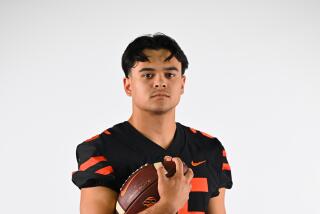2 Years Often Lead to Division I
- Share via
For many athletes, competing at a junior college instead of a Division I school with a long and glorious sports tradition is a far cry from what they envisioned during their high school days.
As their athletic achievements start to turn heads, most young athletes already are dreaming of playing for a leading national program in packed stadiums and arenas. Duke, Florida State, North Carolina, Notre Dame, UCLA, USC. Any of those, and many others, would do.
The local junior college, however, doesn’t make their “A” list.
Their ambitions of attending a prestigious university, coupled with the stigma that many believe is attached to settling for junior college, tilt the scales to one side.
And, yes, there are negatives involved for some athletes who land at a junior college. Perhaps they neglected their academics in high school and it cost them a scholarship to Big Time U. Maybe their athletic accomplishments somehow were overlooked by recruiters from major colleges. Or perhaps they bounced back to a junior college to regroup after a difficult time at a four-year school.
Whatever the reason, junior colleges give those athletes a chance for redemption. The wise ones take advantage of the opportunity, using the two years--and sometimes only one--at that level as a bridge to their original goal. In some cases, it’s quite a primer.
Those who think junior college athletics is little more than a dumping ground better reconsider. I, for one, had to.
After not attending a junior college sport events for many years, I was reacquainted with them this year. At first, it was purely out of duty--it was my job. But I gradually started to tune in to the teams and the players’ personalities. If there is one thing junior colleges don’t lack, it’s interesting subjects.
One of those was Valley quarterback Sean Fitzgerald.
Fitzgerald, 6-feet-5 and 211 pounds, played for the Monarchs this year after spending two seasons at Idaho State. He chose Idaho State after leaving Agoura High but redshirted at quarterback the first season and was converted to free safety the next. The Bengal coaches asked him to switch positions again in 1993 and Fitzgerald balked.
Because he didn’t want to sit out one year by transferring to another Division I school, as would have been dictated by NCAA rules, Fitzgerald opted for Valley.
Fitzgerald passed for a school single-season record 3,121 yards and 27 touchdowns and was named the Western State Conference South Division offensive player of the year. He led the Monarchs to a 9-2 record, including a 21-19 come-from-behind victory over Moorpark in the K-Swiss Bowl on Dec. 4 with electrifying fourth-quarter passing. He earned himself another shot at playing quarterback for a Division I team.
Last week, Fitzgerald signed a letter of intent with Pittsburgh, adding to the list of countless junior college athletes who preceded him to major colleges and even professional leagues.
The names include Detroit Lion quarterback Erik Kramer (Pierce and North Carolina State), J.R. (now Isaiah) Rider (Antelope Valley College and UNLV), an off guard with the Minnesota Timberwolves, and Cedric Ceballos (Ventura College and Cal State Fullerton), a forward with the Phoenix Suns.
Even running back O.J. Simpson (City College of San Francisco, USC, the Buffalo Bills and San Francisco 49ers in the NFL), a member of the Pro Football Hall of Fame, and quarterback Warren Moon of the Houston Oilers (West L.A. College, Washington and the Edmonton Eskimos of the Canadian Football League) graced the junior college athletic fields.
Their ability and success drilled holes in the unfounded theory that junior colleges only attract second-rate athletes. Fitzgerald, and many others, also proved that theory wrong this year.
More to Read
Get our high school sports newsletter
Prep Rally is devoted to the SoCal high school sports experience, bringing you scores, stories and a behind-the-scenes look at what makes prep sports so popular.
You may occasionally receive promotional content from the Los Angeles Times.






